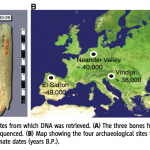genomes
This week, Science published two papers about the genetics of Neandertals from a team of scientists based at the Max Planck Institute of Evolutionary Anthropology. The first (which is the only one anyone seems to really care about) gives a draft version of the entire Neandertal genome - a whopping 4 billion base pairs of DNA. They use this information to look for genomic regions that may have been affected by positive selection in ancestral modern humans that led to their separation from Neandertals, and found some very interesting ones that include genes involved in metabolism and in…
A few months ago we learned via an unintentionally leaked press release that a team of researchers lead by Nicole Gerardo and Cameron Currie had won a Roche Applied Sciences grant competition. The team will be sequencing the complete genome of 14 players from the ant/fungus/microbe co-evolutionary system, including three attine ants from different genera.
The announcement is now official.
An Acromyrmex queen, with brood, in the fungus garden
Today, Roche announced funding for over a dozen genomes of organisms associated with the agricultural attine ants and the fungus they cultivate. In honor of the occasion, here's a sampling of a few of the attine species and their gardens.
Acromyrmex sp. nr. crassispinus, Argentina.
The fungus of the texan species Mycetosoritis hartmanni is grown on a substrate of caterpillar frass. Not all the attines are leaf-cutters!
Acromyrmex lundii, Argentina.
Apterostigma auriculatum, Panama.
Atta texana, Texas.
Cyphomyrmex wheeleri, Arizona.
Trachymyrmex pomonae, Arizona.
The…
Cofactor Genomics is offering to sequence a genome for a few classes for free using Next Generation DNA Sequencing technology (either Illumina GA or via AB SOLiD).
Quoting from their site:
Cofactor will ask course organizers for a 1 page description of how their ~700Mb sequencing project could be used as an effective teaching aid in their class. We will review and choose the best entries during the month of May. Those entries will be awarded a free sequencing project including project experimental design, sample QC, library construction, sequencing, and computational analysis. Those projects…
This is the sixth of eight posts on evolutionary research to celebrate Darwin's bicentennial.
Physically, we are incredibly different from our ape cousins but genetically, it's a different story. We famously share more than 98% of our DNA with chimpanzees, our closest living relatives. Our proteins are virtually identical and our chromosomes have more or less the same structure. At the level of the nucleotide (the "letters" that build strands of DNA), little has happened during ape evolution. These letters have been changing at a considerably slower rate than in our relatives than in other…
This weekend, Arizona State University is hosting a slate of myrmecologists to brainstorm on ant genomes. I'd link to the meeting information, but apparently the gathering is so informal that they've not given the event a web page. In any case, the topic is this: in the age of (relatively) cheap genomes, which ants should we sequence? And, what should we do with the assembled data?
I originally planned to attend, but life intervenes and I'm frozen to the tundra of central Illinois. Instead, I will register here a few suggestions about which species should…
I read about this in Bio-IT World and had to go check it out. It's called the Genome Projector and it has to be the coolest genome browser I've ever seen.
They have 320 bacterial genomes to play with. Naturally, I chose our friend E. coli. The little red pins in the picture below mark the positions of ribosomal RNA genes (It's not perfect, at least one of these genes is a ribosomal RNA methyltransferase and not a 16S ribosomal RNA.)
I'm not entirely happy about finding it now, after I've already written and posted all the assignments for my class, but still, I'll post a link for my…

